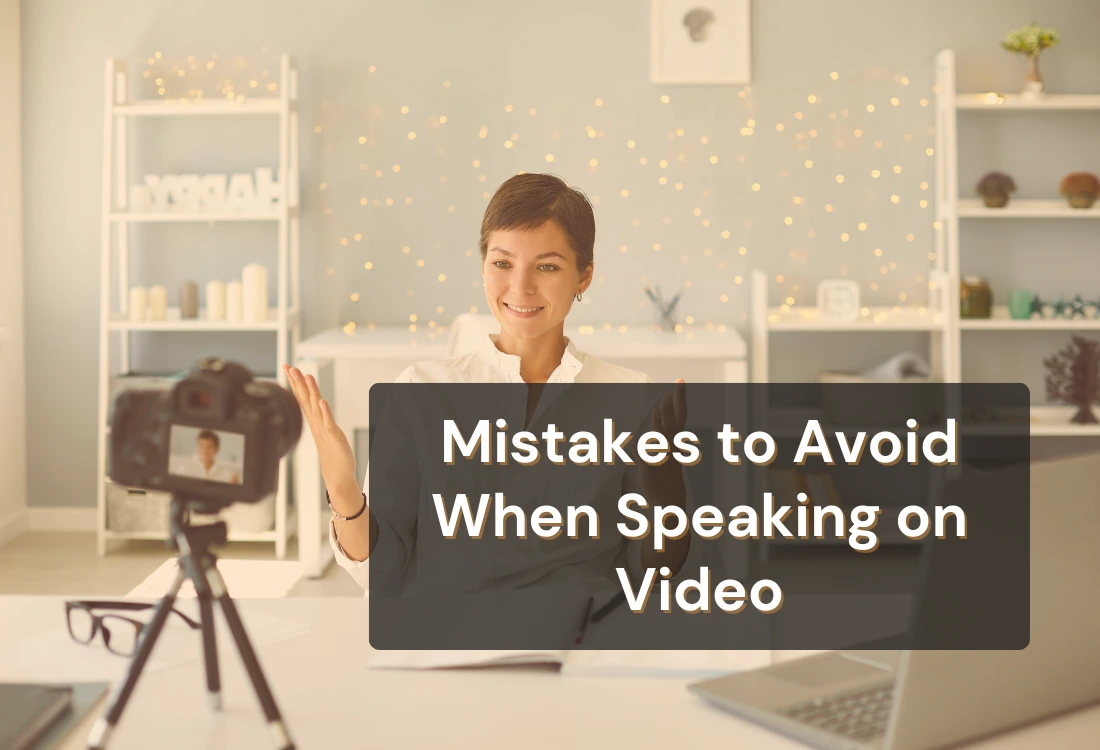



While you might feel confident speaking off-camera, this doesn't always translate to effective on-camera communication. Many people, even experienced speakers, cringe when rewatching their videos.
This guide offers strategies to help you avoid common mistakes when speaking on video. Our aim is to help you look and sound your best, allowing you to effectively connect with your audience and enhance your overall video presence.
The ability to present confidently and effectively on video has become essential due to the widespread use of video communication in various professional settings, including virtual meetings, webinars, online training sessions, product demonstrations, and promotional videos. This skill can greatly influence how your message and credibility are perceived, ultimately impacting the overall success of your professional endeavors.
A confident and compelling video presence can capture your audience's attention, enhance your message, and foster trust and engagement. Conversely, a lack of confidence or poor video presentation skills can detract from your message, undermine your credibility, and leave a lasting negative impression on your viewers. Therefore, honing your on-camera presentation skills is essential for anyone looking to succeed in the modern workplace.

To help you communicate more clearly and confidently, here are the most common mistakes to avoid when speaking on video—and how you can fix them.
When speaking on video, avoid making the common mistake of poor eye contact.Shifting your gaze or looking at your own image instead of the camera lens creates an immediate sense of disconnection. Eye contact conveys trustworthiness and sincerity, while helping build a stronger connection with your viewers. A simple trick to maintain focus is placing a small sticky note or an object behind your lens. Practicing short recordings focused entirely on maintaining eye contact can dramatically improve your on-screen presence.
The overall quality of the audio can strongly influence a viewer's experience. Minor visual imperfections are often overlooked, but poor sound tends to drive audiences away quickly. Common issues such as background noise, echo, or inconsistent volume can distract from your message and diminish your credibility. To avoid these problems, it's important to invest in a good external microphone, choose a quiet, controlled environment for recording, and always test your audio setup before going live or hitting record. Crisp, clear audio ensures your audience stays focused on what you have to say.
Inadequate preparation prior to recording often leads to disjointed thoughts, excessive filler words, and overall rambling.Proper preparation not only enhances message clarity but also boosts confidence and reduces the likelihood of nervous habits. Draft an outline covering key points, rehearse naturally without rigid memorization, and record practice runs for self-review. TEDx speakers, for instance, often rehearse dozens of times to deliver talks that feel natural yet polished.
Lighting can dramatically affect how professional you appear on camera. Strong backlighting, uneven lighting across your face, or overhead shadows can make even the best speaker look unprofessional. Use soft, front-facing light sources whenever possible. Natural daylight from a window can work wonders, but artificial options like softboxes or ring lights positioned at eye level are also effective. Proper lighting doesn’t have to be expensive; even a well-positioned desk lamp with a diffuser can greatly improve your video quality.
Your background plays a crucial role in how your message is received. A cluttered or chaotic environment pulls focus away from your words. Common distractions include messy shelves, bright or patterned walls, and movement from pets or other people. Aim for clean, neutral spaces with minimal, intentional decor. If you opt for a virtual background, ensure it’s static and professional to avoid further distractions.
Non-verbal cues speak volumes. Poor body language, such as slouching, limited facial expression, or fidgeting, can weaken the impact of your message. Sitting or standing tall, smiling naturally where appropriate, and using controlled gestures helps project confidence and authenticity. Research by Dr. Albert Mehrabian shows that body language accounts for 55% of communication effectiveness, proving it’s a critical element you can't afford to overlook.
Speech pacing significantly influences how your audience absorbs your message. Speaking too fast can overwhelm and frustrate viewers, while dragging too slowly risks losing their attention altogether. The key is to find a balance. Insert brief pauses to let important points sink in, focus on deep, measured breathing, and record practice sessions to monitor your natural speaking rhythm. Adjust accordingly to keep your audience engaged.
Keeping your audience engaged is critical if you want your message to leave a lasting impression. Speaking at your audience instead of connecting with them can make your delivery feel flat and impersonal. Instead, use rhetorical questions, share relatable anecdotes, and maintain a conversational tone to create a sense of dialogue. Storytelling, in particular, is a powerful way to capture attention and help your key points resonate more deeply.
Excessive use of filler words such as "um," "like," and "you know" weakens your authority and distracts from your key points. Learning to embrace natural pauses is far more powerful. Practice slow, deliberate speech and listen back to your recordings to self-correct. Try delivering a two-minute talk without any filler words as a training exercise—you'll notice immediate improvements in your articulation and professionalism.
How you present yourself visually leaves a lasting impression. Clothing choices should be deliberate: opt for solid, neutral colors and avoid busy patterns or shiny fabrics that might distract. Proper grooming is just as important to avoid unwanted shine or disheveled appearances on camera. Always match your attire to the tone of your message, ensuring it aligns with the expectations of your audience, whether formal, business casual, or creatively professional.

Deliberate practice and consistent recording of yourself are essential first steps to improving your public speaking and delivery skills. This provides you with an objective view of your performance. When you watch the footage, do so with a critical eye. Analyze your strengths and weaknesses. Your delivery comprises pacing, tone of voice, facial expressions, and body language. Pay attention to all of these aspects.
To improve, ask trusted peers, mentors, or professionals for feedback. They can offer valuable insights and alternative perspectives. Embrace constructive criticism as a tool for growth.
To avoid feeling overwhelmed, focus on one or two specific areas for improvement at a time. For example, you might start by working on your pacing and posture. Once you've made progress in those areas, you can move on to other aspects of your delivery, such as eye contact or vocal variety.

To truly elevate the quality of your video speaking and leave a lasting impression on your audience, consider investing in a range of tools that can significantly enhance your production value. A teleprompter app can help you deliver your message smoothly and confidently, without stumbling over words or losing your train of thought. Sign up with Teleprompter.com to explore easy-to-use teleprompter solutions and to support your next recording.
High-quality microphones ensure that your voice is clear and crisp, while adjustable lighting kits can create a professional and visually appealing atmosphere. A stable tripod will keep your camera steady, eliminating distracting shakes and wobbles.
Video editing software is another essential tool that allows you to fine-tune your presentation. You can cut out any minor mistakes, awkward pauses, or unnecessary sections, and add music, sound effects, or transitions to create a polished and engaging final product. Additionally, consider using a green screen and background replacement software to transport yourself to different locations or create a more visually interesting backdrop.
Practice and preparation are also key to delivering a compelling video presentation. Rehearse your script multiple times, familiarize yourself with the equipment, and make sure you're comfortable and confident in front of the camera. Engage your audience by maintaining eye contact with the camera and paying attention to your facial expressions and body language.
If you’re unsure where to start, this pre-production checklist guide walks you through the essential steps to streamline your preparation process.
Polished video presentations are achievable by focusing on the fundamental mistakes to avoid when speaking on video. Prioritizing authentic eye contact, investing in good audio, maintaining professional backgrounds, utilizing strong body language, and pacing your speech effectively all contribute to creating an engaging and credible video presence. Even small adjustments in these areas can yield significant improvements.
Next time you prepare to record, focus on one or two areas discussed above, implement the changes thoughtfully, and measure the difference it makes.
Start by focusing on three elements: maintaining direct eye contact with the camera, ensuring clean, high-quality audio, and speaking at a clear, moderate pace. Consistent practice and self-review are the quickest paths to noticeable improvement.
Use soft, front-facing lighting whenever possible. Natural daylight is ideal, but a ring light or softbox positioned at eye level works effectively to create an even, flattering illumination.
Maintaining eye contact through the camera lens fosters trust and personal connection with your audience, helping your message feel directed and sincere.
Conscious pauses and deliberate breathing help reduce reliance on filler words. Practice speaking mindfully and record yourself regularly to monitor your improvement.



